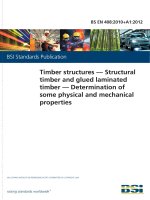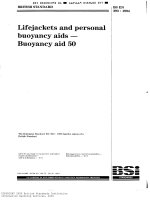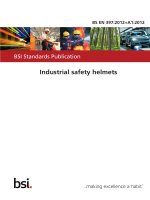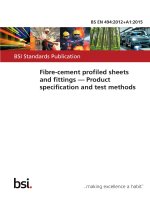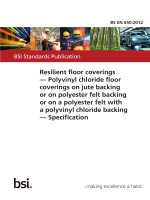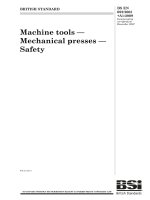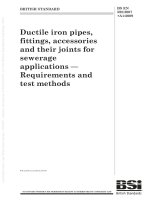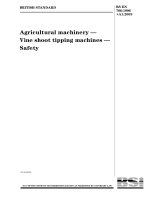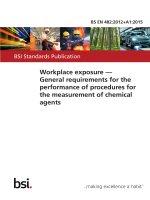Bsi bs en 12828 2012 + a1 2014
Bạn đang xem bản rút gọn của tài liệu. Xem và tải ngay bản đầy đủ của tài liệu tại đây (2.93 MB, 76 trang )
BS EN 12828:2012+A1:2014
BSI Standards Publication
Heating systems in buildings —
Design for water-based heating
systems
BRITISH STANDARD
BS EN 12828:2012+A1:2014
National foreword
This British Standard is the UK implementation of
EN 12828:2012+A1:2014. It supersedes BS EN 12828:2012 which is
withdrawn.
The start and finish of text introduced or altered by amendment is
indicated in the text by tags. Tags indicating changes to CEN text carry
the number of the CEN amendment. For example, text altered by CEN
amendment A1 is indicated by !".
The UK participation in its preparation was entrusted to Technical
Committee RHE/24, Central heating installations.
A list of organizations represented on this committee can be
obtained on request to its secretary.
Guidance to support the use of BS EN 12828:2012+A1:2014 in the UK is
given in National Annex NA (informative).
This publication does not purport to include all the necessary
provisions of a contract. Users are responsible for its correct
application.
© The British Standards Institution 2014.
Published by BSI Standards Limited 2014
ISBN 978 0 580 83107 2
ICS 91.140.10
Compliance with a British Standard cannot confer immunity from
legal obligations.
This British Standard was published under the authority of the
Standards Policy and Strategy Committee on 30 November 2013.
Amendments/corrigenda issued since publication
Date
Text affected
30 April 2014
Implementation of CEN amendment A1:2014
EUROPEAN STANDARD
EN 12828:2012+A1
NORME EUROPÉENNE
EUROPÄISCHE NORM
April 2014
ICS 91.140.10
English Version
Heating systems in buildings - Design for water-based heating
systems
Systèmes de chauffage dans les bâtiments - Conception
des systèmes de chauffage à eau
Heizungsanlagen in Gebäuden - Planung von
Warmwasser-Heizungsanlagen
This European Standard was approved by CEN on 6 October 2012 and includes Amendment 1 approved by CEN on 12 January 2014.
CEN members are bound to comply with the CEN/CENELEC Internal Regulations which stipulate the conditions for giving this European
Standard the status of a national standard without any alteration. Up-to-date lists and bibliographical references concerning such national
standards may be obtained on application to the CEN-CENELEC Management Centre or to any CEN member.
This European Standard exists in three official versions (English, French, German). A version in any other language made by translation
under the responsibility of a CEN member into its own language and notified to the CEN-CENELEC Management Centre has the same
status as the official versions.
CEN members are the national standards bodies of Austria, Belgium, Bulgaria, Croatia, Cyprus, Czech Republic, Denmark, Estonia,
Finland, Former Yugoslav Republic of Macedonia, France, Germany, Greece, Hungary, Iceland, Ireland, Italy, Latvia, Lithuania,
Luxembourg, Malta, Netherlands, Norway, Poland, Portugal, Romania, Slovakia, Slovenia, Spain, Sweden, Switzerland, Turkey and United
Kingdom.
EUROPEAN COMMITTEE FOR STANDARDIZATION
COMITÉ EUROPÉEN DE NORMALISATION
EUROPÄISCHES KOMITEE FÜR NORMUNG
CEN-CENELEC Management Centre: Avenue Marnix 17, B-1000 Brussels
© 2014 CEN
All rights of exploitation in any form and by any means reserved
worldwide for CEN national Members.
Ref. No. EN 12828:2012+A1:2014 E
BS EN 12828:2012+A1:2014
EN 12828:2012+A1:2014 (E)
Contents
Page
Foreword ..............................................................................................................................................................4
Introduction .........................................................................................................................................................5
1
Scope ......................................................................................................................................................6
2
Normative references ............................................................................................................................6
3
3.1
3.2
Terms, definitions and symbols ...........................................................................................................7
Terms and definitions ...........................................................................................................................7
Symbols ............................................................................................................................................... 10
4
4.1
4.2
4.2.1
4.2.2
4.3
4.3.1
4.3.2
4.4
4.4.1
4.4.2
4.4.3
4.4.4
4.4.5
4.5
4.5.1
4.5.2
4.5.3
4.5.4
4.5.5
4.5.6
4.6
4.6.1
4.6.2
4.6.3
4.7
4.7.1
4.7.2
4.7.3
4.7.4
4.7.5
4.8
4.8.1
4.8.2
4.8.3
4.8.4
System design requirements............................................................................................................. 13
Requirements for preliminary design information .......................................................................... 13
Heat supply.......................................................................................................................................... 14
General ................................................................................................................................................. 14
Sizing ................................................................................................................................................... 14
Heat distribution ................................................................................................................................. 15
General ................................................................................................................................................. 15
Design criteria ..................................................................................................................................... 15
Heat emission...................................................................................................................................... 17
General ................................................................................................................................................. 17
Sizing ................................................................................................................................................... 17
Positioning .......................................................................................................................................... 18
Thermal environment ......................................................................................................................... 18
Surface temperatures ......................................................................................................................... 18
Controls ............................................................................................................................................... 18
General ................................................................................................................................................. 18
Classification....................................................................................................................................... 19
Central control .................................................................................................................................... 19
Zone control ........................................................................................................................................ 20
Local control ....................................................................................................................................... 20
Timing control ..................................................................................................................................... 20
Safety arrangements .......................................................................................................................... 21
General ................................................................................................................................................. 21
Equipment required for sealed systems .......................................................................................... 21
Equipment required for open vented systems ................................................................................ 24
Operational requirements .................................................................................................................. 25
General ................................................................................................................................................. 25
Provision for monitoring operating conditions ............................................................................... 26
Temperature controller ...................................................................................................................... 26
Pressure maintaining control device ................................................................................................ 26
Water level adjustment ....................................................................................................................... 26
Thermal insulation .............................................................................................................................. 26
General ................................................................................................................................................. 26
Undesirable heat losses ..................................................................................................................... 27
Harmful effects of too high temperatures ........................................................................................ 28
Frost protection .................................................................................................................................. 28
5
Instructions for operation, maintenance and use ........................................................................... 28
6
Installation and commissioning ........................................................................................................ 28
Annex A (informative) Control system classification ................................................................................... 29
A.1
Control system classification ............................................................................................................ 29
2
BS EN 12828:2012+A1:2014
EN 12828:2012+A1:2014 (E)
A.1.1
A.1.2
A.1.3
A.1.4
A.2
A.2.1
A.2.2
A.2.3
A.2.4
A.2.5
General ................................................................................................................................................. 29
Heating control system modes .......................................................................................................... 29
Control system performance modes ................................................................................................. 29
Control system classification table ................................................................................................... 29
Examples of control system classification ....................................................................................... 30
Local manual control .......................................................................................................................... 30
Local manual control and central automatic control ....................................................................... 31
Local automatic control and central automatic control .................................................................. 31
Local automatic control and automatic zone control ...................................................................... 33
Local automatic control and central automatic control with optimisation ................................... 33
Annex B (informative) Thermal Environment ................................................................................................. 35
Annex C (informative) Thermal insulation ...................................................................................................... 37
Annex D (informative) Guidance for dimensioning diaphragm expansion vessels and
pressurisation systems (sealed systems) ........................................................................................ 40
D.1
General ................................................................................................................................................. 40
D.2
Expansion vessel size calculation ..................................................................................................... 41
Annex E (informative) Safety valves for heating systems ............................................................................ 44
E.1
Classification ....................................................................................................................................... 44
E.2
General requirements ......................................................................................................................... 44
E.2.1 General ................................................................................................................................................. 44
E.2.2 Materials ............................................................................................................................................... 44
E.2.3 Protection against maladjustments ................................................................................................... 44
E.2.4 Guidance of the moveable parts ........................................................................................................ 44
E.2.5 Easing gear .......................................................................................................................................... 44
E.2.6 Protection of sliding and rotating elements ..................................................................................... 45
E.2.7 Design of coil compression springs ................................................................................................. 45
E.2.8 Transport protections ......................................................................................................................... 45
E.2.9 Pipes, installation and body ............................................................................................................... 45
E.2.10 Marking ................................................................................................................................................. 45
E.3
Calculation of the relief capacity ....................................................................................................... 47
E.4
Requirements for safety valves marked H ........................................................................................ 47
E.4.1 General ................................................................................................................................................. 47
E.4.2 Body and spring cap design .............................................................................................................. 47
E.4.3 Threads on the inlet and outlet .......................................................................................................... 48
E.4.4 Connections ......................................................................................................................................... 48
E.4.5 Calculation ........................................................................................................................................... 48
E.4.6 Setting................................................................................................................................................... 48
E.5
Requirements for safety valves marked D/G/H ................................................................................ 48
E.5.1 General ................................................................................................................................................. 48
E.5.2 Body and spring cap design .............................................................................................................. 49
E.5.3 Design of the valve disc...................................................................................................................... 49
E.5.4 Protection of sliding and rotating elements as well as springs ..................................................... 49
E.5.5 Safety valve with back pressure compensation .............................................................................. 49
E.5.6 Setting................................................................................................................................................... 49
Annex F (informative) A–deviations ................................................................................................................ 53
Bibliography ...................................................................................................................................................... 54
3
BS EN 12828:2012+A1:2014
EN 12828:2012+A1:2014 (E)
Foreword
This document (EN 12828:2012+A1:2014) has been prepared by Technical Committee !CEN/TC 228
“Heating systems and water based cooling systems in buildings”", the secretariat of which is held by DIN.
This European Standard shall be given the status of a national standard, either by publication of an identical
text or by endorsement, at the latest by October 2014, and conflicting national standards shall be withdrawn at
the latest by October 2014.
Attention is drawn to the possibility that some of the elements of this document may be the subject of patent
rights. CEN [and/or CENELEC] shall not be held responsible for identifying any or all such patent rights.
This document includes Amendment 1 approved by CEN on 12 January 2014.
This document supersedes !EN 12828:2012".
The start and finish of text introduced or altered by amendment is indicated in the text by tags !".
The main changes !between EN 12828:2003 and EN 12828:2012 were":
—
restrictions concerning additional safety requirements for systems larger than 1 MW were removed;
—
an informative annex for safety valves was added;
—
definitions were corrected and added;
—
the guidance for dimensioning of diaphragm expansion vessels (sealed systems) in Annex D was revised,
and a figure describing the different pressure level was added;
—
a specification for the water used has been added in 4.3.2.1;
—
the requirements concerning safety arrangements (4.6) were revised and clarified;
—
4.7.4 concerning pressure maintaining control device was revised.
According to the CEN-CENELEC Internal Regulations, the national standards organisations of the following
countries are bound to implement this European Standard: Austria, Belgium, Bulgaria, Croatia, Cyprus, Czech
Republic, Denmark, Estonia, Finland, Former Yugoslav Republic of Macedonia, France, Germany, Greece,
Hungary, Iceland, Ireland, Italy, Latvia, Lithuania, Luxembourg, Malta, Netherlands, Norway, Poland, Portugal,
Romania, Slovakia, Slovenia, Spain, Sweden, Switzerland, Turkey and the United Kingdom.
4
BS EN 12828:2012+A1:2014
EN 12828:2012+A1:2014 (E)
Introduction
The subjects covered by CEN/TC 228 are the following:
—
design of heating systems (water based, electrical, etc.);
—
installation of heating systems;
—
commissioning of heating systems;
—
instructions for operation, maintenance and use of heating systems;
—
methods for calculation of the design heat loss and heat load;
—
methods for calculation of the energy performance of heating systems.
Heating systems also include the effect of attached systems such as hot water production systems.
All these standards are system standards, i.e. they are based on requirements addressed to the system as a
whole and not dealing with requirements to the products within the system.
Where possible, reference is made to other CEN or ISO standards, e.g. product standards. However, use of
products complying with relevant product standards is no guarantee of compliance with the system
requirements.
The requirements are mainly expressed as functional requirements, i.e. requirements dealing with the function
of the system and not specifying shape, material, dimensions or the like.
The guidelines describe ways to meet the requirements, but other ways to fulfil the functional requirements
may be used if fulfilment can be proved.
Heating systems differ among the member countries due to climate, traditions and national regulations. In
some cases, requirements are given as classes so national or individual needs may be accommodated.
In cases where the standards contradict with national regulations, the latter should be followed.
5
BS EN 12828:2012+A1:2014
EN 12828:2012+A1:2014 (E)
1
Scope
This European Standard specifies design criteria for water based heating systems in buildings with a
maximum operating temperature of up to 105 °C. In case of heating systems with maximum operating
temperatures over 105 °C other safety aspects than those described in 4.6 may apply. The other clauses of
this European Standard are still valid for those systems.
This European Standard does not amend product standards or product installation requirements. This
standard covers the design of:
—
heat supply systems;
—
heat distribution systems;
—
heat emission systems;
—
control systems.
This European Standard takes into account heating requirements of attached systems (e.g. domestic hot
water, process heat, air conditioning, ventilation) in the design of a heat supply, but does not cover the design
of these systems.
This European Standard does not cover requirements for installation or commissioning or instructions for
operation, maintenance and use of water based heating systems.
This European Standard does not cover the design of fuel and energy supply systems.
2
Normative references
The following documents, in whole or in part, are normatively referenced in this document and are
indispensable for its application. For dated references, only the edition cited applies. For undated references,
the latest edition of the referenced document (including any amendments) applies.
EN 215, Thermostatic radiator valves — Requirements and test methods
EN 442-1, Radiators and convectors — Part 1: Technical specifications and requirements
EN 442-2, Radiators and convectors — Part 2: Test methods and rating
EN 442-3, Radiators and convectors — Part 3: Evaluation of conformity
EN 806-2, Specifications for installations inside buildings conveying water for human consumption — Part 2:
Design
EN 1264-1, Water based surface embedded heating and cooling systems — Part 1: Definitions and symbols
EN 1264-2, Water based surface embedded heating and cooling systems — Part 2: Floor heating: Prove
methods for the determination of the thermal output using calculation and test methods
EN 1264-3, Water based surface embedded heating and cooling systems — Part 3: Dimensioning
EN 1264-4, Water based surface embedded heating and cooling systems — Part 4: Installation
EN 1264-5, Water based surface embedded heating and cooling systems — Part 5: Heating and cooling
surfaces embedded in floors, ceilings and walls — Determination of the thermal output
6
BS EN 12828:2012+A1:2014
EN 12828:2012+A1:2014 (E)
EN 12170, Heating systems in buildings — Procedure for the preparation of documents for operation,
maintenance and use — Heating systems requiring a trained operator
EN 12171, Heating systems in buildings — Procedure for the preparation of documents for operation,
maintenance and use — Heating systems not requiring a trained operator
EN 12831, Heating systems in buildings — Method for calculation of the design heat load
EN 14336, Heating systems in buildings — Installation and commissioning of water based heating systems
EN 15500, Control for heating, ventilating and air-conditioning applications — Electronic individual zone
control equipment
EN 60730-2-9, Automatic electrical controls for household and similar use — Part 2-9: Particular requirements
for temperature sensing controls (IEC 730-2-9, modified)
EN ISO 7730, Ergonomics of the thermal environment — Analytical determination and interpretation of
thermal comfort using calculation of the PMV and PPD indices and local thermal comfort criteria (ISO 7730)
EN ISO 13732-1, Ergonomics of the thermal environment — Methods for the assessment of human
responses to contact with surfaces — Part 1: Hot surfaces (ISO 13732-1)
3
Terms, definitions and symbols
For the purposes of this document, the following terms, definitions and symbols apply.
3.1 Terms and definitions
3.1.1
attached system
system connected to the heating system which may influence the design and heat load of the system
EXAMPLE
Examples of such systems include:
—
domestic hot water systems;
—
ventilation and air conditioning systems;
—
process heating systems
3.1.2
central control
method of controlling the heat flow to a heat emission system by changing the flow rate and/or the flow
temperature at a central point
3.1.3
design heat load
maximum heat output required from the heating system of a building, in order to maintain required internal
temperatures without supplementary heating
[SOURCE: EN ISO 15927-5:2004, 3.1.1]
3.1.4
design heat loss
quantity of heat per unit time leaving the building to the external environment under specified design
conditions
7
BS EN 12828:2012+A1:2014
EN 12828:2012+A1:2014 (E)
[SOURCE: EN 12831:2003, 3.1.5]
3.1.5
external design temperature
external air temperature which is used for the calculation of the design heat losses
3.1.6
external air temperature
air temperature outside the building
3.1.7
frost inhibitor
supplement to a heating medium lowering its freezing point
3.1.8
heat distribution system
configuration of interconnected components for the dispersal of heat between the heat supply system and the
heat emission system or any attached system
3.1.9
heated space
room or enclosure which is to be heated to the specified internal design temperature
3.1.10
heat emission system
configuration of interconnected components for the dispersal of heat to a heated space
3.1.11
heat gains
quantity of heat generated within or entering into a heated space from heat sources other than the heating
system
3.1.12
heating period
time during which heating is required to maintain the internal design temperature
3.1.13
heat supply system
configuration of interconnected components/appliances for the supply of heat to the heat distribution system
3.1.14
internal design temperature
operative temperature at the centre of the heated space (between 0,6 m and 1,6 m height) used for
calculation of the design heat losses
3.1.15
local control
method of controlling the heat flow to a heat emission system by changing the flow rate or the flow
temperature locally on the basis of the temperature of the heated space
3.1.16
open vented system
heating system in which the heating medium is open to the atmosphere
3.1.17
maximum operating pressure
maximum pressure at which the system, or parts of the system, is designed to operate
8
BS EN 12828:2012+A1:2014
EN 12828:2012+A1:2014 (E)
3.1.18
maximum operating temperature
maximum temperature at which the system, or parts of the system, is designed to operate
3.1.19
operative temperature
arithmetic average of the internal air temperature and the mean radiant temperature
3.1.20
pressure limiter
automatic operating device that causes shutdown and lock out of the heat supply when the maximum
operating pressure of the heating medium is exceeded
3.1.21
sealed system
heating system in which the heating medium is closed to the atmosphere
3.1.22
safety temperature lockout device
device that causes safety shutdown and non-volatile lockout of the heat supply so as to prevent the water
temperature exceeding a preset limit
3.1.23
temperature controller
automatic operating device that causes shutdown of the heat supply when the set operating temperature of
the heating medium is exceeded
Note 1 to entry:
The heat supply will be restored automatically when the temperature of the heating medium falls
below the set operating temperature.
3.1.24
timing control
method of controlling the heat flow to a heat emission system by using a timed program for starting and
shutdown of the heat flow
3.1.25
water level limiter
automatic operating device that causes shutdown and lock out of the heat supply when the set minimum water
level of the heating medium is reached
3.1.26
zone
space or groups of spaces with similar thermal characteristics
3.1.27
zone control
local control of a zone consisting of more than one space
3.1.28
nominal heat output
ΦN
value of the thermal power output of the heat generator as declared by the manufacturer
3.1.29
efficiency
ratio of the heat output to the heat input, expressed in %
9
BS EN 12828:2012+A1:2014
EN 12828:2012+A1:2014 (E)
3.1.30
pressurisation system
system equipment (membrane expansion vessels, compressor-controlled pressurisation units and pumpcontrolled pressurisation units) for pressure maintenance in closed heating systems
Note 1 to entry:
The equipment provides to maintain the system pressure between defined limits and ensures the
required minimal working pressure of the heating system. The equipment holds the accruing expansion water when the
system water is heated and restores the volume when the heating system is cooling down and contracting. Due to the
design of construction the expansion system simultaneously protects the expansion water from corrosion producing
ingress of oxygen.
3.1.31
maximum system safety temperature
highest temperature any component of the heating system can accommodate
3.1.32
lockout
default condition resulting in a shutdown of the system and requiring a manual reset
Note 1 to entry:
lockout.
The intention of a lockout is to require the operator to investigate and eliminate the cause of the
3.1.33
response overpressure
pressure at which a safety valve opens at operating conditions
3.2 Symbols
Table 1 — Symbols used in the standard
10
Symbol
Description
Unit
Amin
narrowest flow section of a safety valve
mm
de
external pipe diameter
mm
dfe
minimum internal diameter of the feed and expansion pipe
mm
din
nominal size of the safety valve’s inlet
dmin
narrowest flow diameter upstream of the valve seat
dout
nominal size of the safety valve’s outlet
ds
minimum internal diameter of the safety pipe
e
expansion coefficient
fAS
design factor for other attached systems
fDHW
design factor for domestic hot water systems
fHL
design factor for the heat load
fnrbl
fraction of heat emission, considered as wasted;
hst
static height
bar
hWin
window height
m
I
operational parameter
C⋅s/year⋅10
K
constant
kW/mm
Kdr
specified reduced discharge coefficient for gases/vapours
/
2
mm
mm
9
2
BS EN 12828:2012+A1:2014
EN 12828:2012+A1:2014 (E)
l
specific latent heat quantity
kJ/kg
pabs
absolute pressure in the system (set pressure + admissible pressure
increase)
bar
pfil
filling pressure – the required pressure in the system if the lowest
possible temperature is not given (for filling or water make-up)
bar
pfin
final pressure
bar
pini
initial pressure
bar
pv
vapour pressure
bar
p0
minimum operating pressure
bar
pPAZ
pressure at which the pressure limiter operates
bar
pst
static height pressure
bar
psv
set pressure of the safety valve
Bar
t
time
s
UL
linear thermal transmission coefficient for pipes
W/m⋅K
UW
thermal transmittance of the outside wall/window
W/m²⋅K
Vex
expansion volume
m
3
VN
nominal volume of the expansion vessel to be determined
m
3
VN,min
minimum nominal volume
m
3
VSystem
total water content of the system
m
3
Vwr
real water reserve volume in the pressure vessel used
m
3
Vwr,min
minimal water reserve volume
m
3
x
coefficient of pressure medium for saturated steam
α
coefficient for valve design
η
utilisation degree
Φ
heating capacity
kW
ΦAS
capacity of other attached systems
kW
ΦDHW
domestic hot water capacity
kW
ΦHL
heat load capacity
kW
ΦN
nominal heat output
kW
ΦSU
capacity of the heat supply system
kW
λ
thermal conductivity of the insulation material
W/m⋅K
ρϑfil
density of water at the average system temperature during fill or makeup process
kg/m
3
ρϑmax
density of water at the maximum set operating temperature
kg/m
3
ρϑmin
density of water at the lowest system temperature
kg/m
3
ϑ
temperature
°C
ϑa
air temperature
°C
ϑd,e
external design temperature
°C
2
(h⋅mm ⋅bar)/
kg
11
BS EN 12828:2012+A1:2014
EN 12828:2012+A1:2014 (E)
ϑd,jnt
internal design temperature
°C
ϑenv
temperature of the surrounding environment
°C
ϑo
operative temperature
°C
ϑr
mean radiant temperature
°C
ϑW
surface temperatures of outside wall/window
°C
ϑw
water temperature
°C
Table 2 — Indices used in the standard
12
Index
Definition
a
air
abs
absolute
AS
other attached systems
d
design
DHW
domestic hot water systems
dr
reduced discharge
e
external
env
environment
ex
expansion
fe
feed and expansion
fil
filling
fin
final
HL
heat load
in
Inlet
ini
initial
int
internal
j
summation index
L
linear thermal transmission
max
maximum
min
minimum
N
nominal
nrbl
heat emission, considered as wasted
o
operative
0
minimum operational
out
outlet
PAZ
pressure limiter
r
radiant
s
safety
BS EN 12828:2012+A1:2014
EN 12828:2012+A1:2014 (E)
4
st
static
SU
heat supply system
sv
safety valve
System
system
V
vapour
w
water
W
outside wall/window
Win
window
wr
water reserve
ϑmax
maximum system temperature
ϑmin
minimum system temperature
System design requirements
4.1 Requirements for preliminary design information
The heating system shall be designed, installed and operated in a way that does not damage the building or
other installations and with due consideration to minimise energy use.
The heating system shall be designed with due consideration to installation, commissioning, operation,
maintenance and repair of components, appliances and the system.
At the planning stage or during the progress of design work, the following items shall be agreed upon and
documented:
a)
clarification of the responsibilities of the designer and the installer and whether or not a qualified operator
is required;
b)
compliance with relevant local or statutory regulations;
c)
thermal characteristics of the building for calculation of heat requirements and possible improvements of
energy conservation;
d)
external design temperature;
e)
internal design temperature;
f)
method of heat load calculation;
g)
energy source;
h)
position of the heat generator, bearing in mind access for maintenance, means of flueing and provision of
combustion air;
i)
type, location, dimensions, construction and suitability of chimney and flue terminal, if required;
j)
location and size of fuel storage and access thereto, if required;
k)
consideration of solid fuel, ash removal and disposal;
13
BS EN 12828:2012+A1:2014
EN 12828:2012+A1:2014 (E)
l)
choice of suitable pressurisation,
m) position of feed and expansion cistern for open vented systems or expansion vessel, filling point and
pressure gauge for sealed systems;
n)
facilities for filling and draining the system;
o)
power requirements of any attached system;
p)
type and position of heat emitters;
q)
control system of heating and attached system, including frost protection;
r)
route and method of installing piping and insulation;
s)
provisions and specification for balancing the system;
t)
provision for measurement of energy consumption;
u)
surface temperatures of exposed heating system surfaces;
v)
provision for water treatment;
w) requirements for extra heating up capacity, including night-set-back or intermittent heating according to
EN 12831 and buffer storage for hot water systems;
x)
determination of the design factors
fHL , fDHW and fAS (see 4.2.2).
4.2 Heat supply
4.2.1
General
The heat supply system shall be designed to satisfy the design heat load of the building and the requirements
of any attached system. The design heat load of the building shall be calculated in accordance with EN 12831.
NOTE
The determination of the thermal power of other attached systems is not part of this European Standard.
Any other recognised heat load calculation method may only be used if accepted by the client.
The heat supply system shall be designed and dimensioned taking into account the type of energy source.
4.2.2
Sizing
The heat supply to serve the system shall be sized to meet the design heat load and the necessary additional
heat supply requirements of any attached domestic hot water and other attached systems in accordance with
the specifications agreed upon in 4.1.
If the total heat supply is provided by more than one heat generator or heat source, the following points shall
additionally be considered:
—
the fraction of the heat load supplied by each heat generator;
—
different operating periods, such as summer and winter;
—
different operating conditions, such as for heating or for hot water;
—
operating requirements, such as standby.
14
BS EN 12828:2012+A1:2014
EN 12828:2012+A1:2014 (E)
The capacity of the heat supply system shall be calculated as follows:
ΦSU = fHL ⋅ ΦHL + fDHW ⋅ ΦDHW + f AS ⋅ ΦAS
(1)
where
ΦSU
is the capacity of the heat supply system in kilo watts (kW);
fHL
is the design factor for the heat load;
ΦHL
is the design heat load of the building in kilo watts (kW);
fDHW
is the design factor for domestic hot water systems;
ΦDHW
is the domestic hot water capacity in kilo watts (kW);
f AS
ΦAS
is the design factor for other attached systems;
is the capacity of other attached systems in kilo watts (kW).
The design factors
fHL , fDHW and fAS shall be determined on an individual basis subject to national
limitations. It should be considered that the above heat load capacities may not be cumulative and the heat
supply capacity should be determined based on agreed criteria for their demand.
4.3 Heat distribution
4.3.1
General
The heat distribution system shall be designed to distribute the heat supply to the heat emission system and, if
necessary, to any attached systems.
The heat distribution system, including sub-circuits, shall be designed so as to enable hydraulic balancing.
Consideration shall be given to any variety of demand for attached systems and to the quality of the water.
Consideration shall be given to separate circuits for each type of heat emission system, the zoning
requirement of buildings and the supply temperature and temperature difference of each heat emission
system.
Provision for filling, draining and venting shall be provided for each circuit.
4.3.2
4.3.2.1
Design criteria
Water requirements
The composition of the water used in the heating system shall be such that the function of the system
components is maintained in order to guarantee a safe and economic operation.
Parameters for consideration may include:
—
the chemical characteristics of the water, e.g. pH, O2, chlorine and derivates, content of alkaline-earthand hydrogen carbonate ions and carbonates;
—
the electrical conductivity.
When necessary, supplements for water preparation, water treatment and/or anti-freeze, shall be used in
accordance with the appropriate manufacturers’ requirements.
15
BS EN 12828:2012+A1:2014
EN 12828:2012+A1:2014 (E)
Further information can be found in VDI 2035.
NOTE
The following factors influence the quality of the water in the heating circuit:
−
deterioration of the heat transfer on the transmission surfaces due to calcification;
−
impairment of the function of the components due to sedimentation of corrosion products or component failure due to
corrosion;
−
oxygen insertion due to defective pressurisation or diffusion/permeation at membranes, plastic pipes, seals, etc.
4.3.2.2
Water flow rate
The water flow rate and the initial setting of the balancing devices shall be stated and documented according
to the flow rate requirements of the heat supply system as well as the heat emission system and any attached
systems.
Consideration shall be given to:
—
balancing devices;
—
hydraulic decoupling devices;
—
speed-controlled circulation pumps.
4.3.2.3
Circulation pumps
Circulation pumps shall be sized so that at any point of the system the flow rate and the pressure difference
required to fulfil the heat load are available.
Consideration shall be given to:
—
the number of pumps, including stand-by provision;
—
characteristic curves and the optimum range of application;
—
the variable flow control system;
—
minimising the electric power required;
—
provisions for insulation;
—
noise transmittance;
—
speed controlled circulation pumps and their operation mode;
—
automatic on- off control;
—
the static height provided at the suction side of the circulation pump, in accordance with the pump
manufacturer’s instructions, e.g. to avoid cavitation.
4.3.2.4
Pipework
Pipework shall be designed and sized so that at any point of the system the flow rate and the pressure
difference required to fulfil the heat load are available. Pipework and thermal insulation material shall be
compatible.
Consideration shall be given to:
16
BS EN 12828:2012+A1:2014
EN 12828:2012+A1:2014 (E)
—
temperature;
—
design pressure;
—
pressure drop;
—
energy demand regarding electric power of the circulation pumps;
—
corrosion and component compatibility, including glands and seals;
—
noise transmittance, i.e. flow velocity and mechanical noise;
—
thermal expansion and contraction;
—
pipework routing and physical protection, thermal insulation, accessibility for inspection and repairs;
—
measurement of energy consumption;
—
resistance to fire;
—
oxygen permeability;
—
service and maintenance, including filling, draining down and venting.
4.4 Heat emission
4.4.1
General
Heat emitters shall be selected on the basis of design heat load.
Consideration shall be given to:
—
the design heat load;
—
the system flow temperature;
—
thermal comfort and noise in occupied spaces;
—
safety of the occupants, e.g. surface temperature of the heat emitters;
—
protection and prevention of damage to the building components;
—
maintenance requirements, e.g. cleaning and repair;
—
compatibility with heat supply, heat distribution and control system.
Thermal comfort should be in accordance with EN ISO 7730, where specified.
4.4.2
Sizing
Heat emitters shall be sized in accordance with the space by space design heat load calculated in accordance
with EN 12831, with due allowance for heat emission from other system components, such as pipework.
The size of the emitter, temperature of the emitter and water flow rates shall be determined on the basis of
manufacturer's data sheets according to EN 442, Part 1 to 3 or EN 1264, Part 1 to 5.
17
BS EN 12828:2012+A1:2014
EN 12828:2012+A1:2014 (E)
The design shall include consideration of factors that can affect the output of the emitter and take into account
that such effects are often cumulative, e.g. casing, connections, water flow rate, covering, paint, carpets,
drapes.
Depending on the original design parameters, the designer may consider an additional allowance on the heat
emitter output, e.g. for systems that are being operated intermittently (see EN 12831).
Depending on the type of heat emission system in rooms with high ceilings, a high vertical air-temperature
difference may occur, rather than the uniform temperature assumed in the heat loss calculations. In such
cases an additional allowance on emitter output may be necessary (see EN 12831).
4.4.3
Positioning
In choosing the location of heat emitters, consideration shall be given to the overall effect upon the control of
room temperatures and comfort conditions.
The positioning, type, number and size of the heat emitters in a space, together with the thermal transmittance
of windows and/or walls, will influence the differences in the operative temperatures in the space, the radiant
temperature asymmetry and draught.
When positioning heat emitters, the manufacturer's specific mounting requirements shall be considered.
4.4.4
Thermal environment
If required by the client, documentation and, if appropriate, calculation criteria of the thermal environment shall
be fulfilled in accordance with EN ISO 7730, i.e. difference in operative temperature, radiant temperature
asymmetry and draught.
4.4.5
Surface temperatures
In special cases, e.g. schools, nurseries and homes for the elderly, infirm or disabled, the surface
temperatures of heat emitters shall be limited in accordance with local or statutory requirements (see
EN ISO 13732-1 and EN 1264-3).
4.5 Controls
4.5.1
General
Control of the heating system shall enable the specified designed indoor temperatures to be achieved under
the specified variation of internal loads and external climate and, if specified, protect buildings and equipment
against frost and moisture damage when normal comfort temperature level is not required.
Heating systems shall be equipped with automatic and/or manual control devices. Manually operated valves
should not be used in connection with radiators and embedded heating systems, as they are not self-acting
and control function is not provided.
NOTE
Thermostatically controlled valves are not considered as manually operated valves.
Classes for devices are given in Annex A.
The design of control systems shall take into account the building, its intended use and the effective
functioning of the heating system, the efficient use of energy and avoiding heating the building to full design
conditions when not required. This shall include keeping distribution heat losses as low as possible, e.g.
reducing flow temperature when normal comfort temperature level is not required.
Additional control requirements may be necessary in accordance with other component manufacturer's
instructions.
18
BS EN 12828:2012+A1:2014
EN 12828:2012+A1:2014 (E)
Self-acting thermostatic radiator valves, excluding differential pressure independent radiator valves, shall
comply with EN 215.
Electronic radiator thermostats shall comply with EN 15500.
4.5.2
Classification
The control system shall be classified as follows:
a)
b)
classification based on heating control system level:
—
Central control
(C);
—
Zone control
(Z);
—
Local control
(L).
classification based on control system performance level:
—
Manual
(M),
—
Automatic
(A),
—
Timing function
(T),
—
Advanced timing function
(O).
For details, see Annex A.
4.5.3
4.5.3.1
Central control
General
Central control of the heat flow to the heat distribution system shall be provided.
The central control, or part of it, can in some cases be part of the heat supply, e.g. a temperature controller on
a heat generator.
In heating systems with single heating circuits, the indoor temperature may be controlled by the boiler control
thermostat, draught regulator, circulation pump or time and central temperature control.
4.5.3.2
Heat flow to the distribution system
The heat flow to the heat distribution system shall be controlled to supply water with a heat content required
by the heat emission system.
The heat flow to the heat distribution system depends on design criteria for the heating system relative to
indoor and outdoor conditions, e.g. air temperature, wind and direct solar radiation.
The heat flow can be manually or automatically controlled. Care should be taken when locating and fixing
sensors to ensure that the position chosen is representative. Outside air temperature sensors should be
positioned so as not to be exposed to direct solar radiation and to avoid influences from any hot or cold
sources, unless the control is designed to take account of such factors.
4.5.3.3
Heat flow rate to attached systems
The heat flow rate to the attached systems shall be controlled by central control of the heat supply in
accordance with the heat demand of the attached systems.
19
BS EN 12828:2012+A1:2014
EN 12828:2012+A1:2014 (E)
4.5.4
Zone control
If specified, the heating system shall be divided into zones in the interests of energy conservation,
measurement of energy consumption and indoor zone temperature control.
The temperature sensor for the controller shall be located in a position representative of the entire zone.
If the system is subdivided into zones, the design shall ensure that all emitters in different spaces of a zone
have the same required operational parameters.
The spaces of a zone shall be selected in such a way that internal and solar gains are approximately the
same both in rate and value.
Examples for controlling indoor zone temperature are given in Annex A.
4.5.5
Local control
In order to achieve specific indoor temperatures, under varying loads, each heated space shall be equipped
with local control. Local control can be achieved by manual or automatic regulation.
Local control shall enable the user to set up individual temperature preferences within the specified range.
The local controller shall be fitted in a position readily accessible to the user.
A local control may control one individual heat emitter or a group of heat emitters.
The control of the indoor temperature is influenced by the response time of the building (thermal mass), the
response time of the heating system and the control strategy.
Automatic local control is especially useful for convenience of the users, for achieving possible energy savings
and for adjusting for heat gains from internal loads or solar radiation.
Temperature sensors shall be fitted in a representative location to maintain design conditions, and so that
undesirable effects from direct solar radiation, curtains, etc. are prevented.
4.5.6
Timing control
Timing control shall be installed in the interest of energy conservation and reduced operating costs.
The supply of heat shall be controlled according to the use of the building, e.g. residential buildings, office
buildings, schools, and its thermal characteristics, such as insulation, thermal inertia, etc., in one of the
following ways:
— ON/OFF control;
— set-back control;
— intermittent control;
— optimising control.
Timing control can be used to provide a variable heat flow rate. Timing control can regulate the supply
temperature or supply flow rate.
20
BS EN 12828:2012+A1:2014
EN 12828:2012+A1:2014 (E)
4.6 Safety arrangements
4.6.1
General
Heating systems shall be equipped with safety arrangements against:
— exceeding the maximum operating temperature;
— exceeding the maximum operating pressure;
— lack of water.
Safety arrangements shall be designed in accordance with:
— the type of heating system, i.e. sealed or open vented system, and its pressurisation;
— the type of energy source;
— the way in which the heat supply is provided to the heating system, i.e. automatically controlled or manually
operated;
— the nominal output of the heat supply system.
Safety arrangements, whether provided by the appliance manufacturer as a built-in part of the heat generator
or not, shall be an integral part of the heating system. The appliance manufacturer’s installation instructions
shall be complied with.
4.6.2
4.6.2.1
Equipment required for sealed systems
Protection against exceeding the maximum system safety temperature
Each heat generator shall be served by a safety temperature lockout device which prevents the heat
generator flow temperature exceeding the maximum system safety temperature. The set point temperature of
the safety temperature lockout device shall be chosen accordingly. A typical system temperature development
in a fault condition is shown in Figure 1.
This lockout device can be a safety temperature limiter, which shall conform to EN 60730-2-9.
If the heat generator is not equipped with such a lockout device by the manufacturer, it shall be fitted on the
generator flow pipe as near as possible to the heat generator.
A lockout device is not required if the heat generator intrinsically cannot exceed the maximum system safety
temperature (e.g. heat pumps).
21
BS EN 12828:2012+A1:2014
EN 12828:2012+A1:2014 (E)
Key
1
set operating temperature (shall not exceed 105 °C)
2
lockout set point temperature
3
generator lockout
4
maximum system safety temperature
ϑ
temperature
t
time
Figure 1 — Typical system temperature development in a fault condition
If the heat supply system is a heat exchanger, the following applies:
If the operating temperature on the primary side is higher than the maximum operating temperature on the
secondary side, a safety temperature limiter complying with EN 60730-2-9 is necessary. The limiter shall deenergise the energy supply on the primary side of the heat exchanger via a shut-off device.
NOTE
For solid fuel appliances a heat distribution circuit can be provided to operate in an overheat situation.
4.6.2.2
Protection against exceeding the maximum operating pressure
4.6.2.2.1
Safety valves, rating and arrangements
Each heat generator of a heating system shall be served by at least one safety valve in order to protect the
system against exceeding the maximum operating pressure. If the heat generator is not equipped with a
safety valve by the manufacturer, such a device shall be fitted on the system as near as possible to the heat
generator.
In using more than one safety valve, the smaller valves shall have a discharge capacity of at least 40 % of the
total flow.
The safety valve(s) shall be sized to serve the total pressure developed in the system or parts of the system.
Safety valve(s) shall:
—
have a minimum size of DN 15;
—
open at a pressure not exceeding the maximum design pressure of the system and shall be designed to
prevent the maximum operating pressure from being exceeded by more than 10 %, except for maximum
operating pressures not exceeding 3 bar a deviation of 0,5 bar is permissible. Possibilities to achieve
these requirements are given in Annex E;
22
BS EN 12828:2012+A1:2014
EN 12828:2012+A1:2014 (E)
NOTE
The information given in Annex E on safety valves is for informational purposes only and not meant to
interfere with any product standard.
—
be installed so that the pressure drop of the inlet pipe does not exceed 3 %, and the pressure drop of the
discharge pipe does not exceed 10 % of the safety valve set pressure.
Safety valves shall be installed in an accessible location in the immediate vicinity of the heat generator flow
pipe. There shall be no isolation valve between the heat generator and the safety valve(s).
To ensure a safe discharge of water and potentially forming of steam the relief pipe of the safety valve shall be
dimensioned and positioned accordingly.
Heat generators with a heat capacity of more than 300 kW shall be served by an expansion trap within the
relief pipe in the immediate vicinity to the valve. This shall be connected to a vapour discharging pipe rising to
the open air and provide a safe water drain pipe (design according to Annex E). This also applies to heat
exchangers, from which steam forming in case of a system failure cannot be ruled out. An expansion trap may
not be necessary in cases in which each heat generator or heat exchanger is served by an additional
temperature limiter and an additional pressure limiter.
4.6.2.2.2
Pressure limiter
Each heat generator greater than 300 kW nominal heat output shall be served by a pressure limiter to prevent
the maximum set pressure to be exceeded.
If the heat generator is not equipped with a pressure limiter by the manufacturer, such a device shall be fitted
on the system as near as possible to the heat generator.
Where other assisting heat supply systems are present, e.g. solar systems, their specific safety requirements
shall apply.
If the operating pressure of the heating system exceeds the given pressure limit, the pressure limiter shall
shut-off the heating or fuel supply and interlock it against automatic restoring.
The pressure limiter shall be adjusted so that it responds before the safety valve(s) operate.
Systems served by heat exchangers may not require pressure limiters.
4.6.2.3
Safeguard against lack of water
!Sealed heating systems, except electrode type heat generators and heating systems on the secondary
side of heat exchangers, shall be equipped with a water level limiter or other device, e. g. minimum pressure
limiter or flow controller, thus providing interlock protection against excess temperature rise on the heat
emitting surface of the heat generator.
A water level limiter or other appropriate device is not required with generators up to 300 kW nominal heat
output, if it is ensured that an unacceptable temperature rise cannot occur when there is lack of water.
If the generator is located higher than most of the heat emitters, a water level limiter or other appropriate
device shall be used for all heat generators."
4.6.2.4
Pressurisation systems
Each heat generator shall be individually connected to a pressurisation system by means of an expansion
pipe. In cases where several heat generators are connected to the same pressurisation system, unintended
circulation within the expansion pipes shall be avoided.
23
